
Creating content that converts is tricky.
On one side, you have the content. If done correctly, it offers practical advice, gives relevant examples, solves reader’s problems, mitigates their pain, provides a solution, and answers a question.
On the other side, you have the desire to convert readers with that same piece of content. You want to sell them your product, generate leads, and make that piece of content worth more than it costs you to produce.
Many content creators fall victim to erring on one side or the other. Either they create pushy content, or they don’t mention their product.
When it comes to content marketing — one part solution and one part sales — erring too much on either side will kill your campaign.
Generally speaking, content marketing will increase your conversion rate. Conversion rates for content marketing businesses are six times higher than their non-adopting counterparts.

And yet, many of you are still experiencing few or no results.
Either you’re too pushy, or you’re not asking for the sale.
Success isn’t at one extreme or the other, but somewhere in the middle.
In other words, your content should help your audience and make money.
Here are 8 ways to solve and sell with your content marketing.
1. Make it hurt a little.
A bit of pain never hurt anyone.
Okay, that was a direct lie.
But, in the world of content marketing, creating a little pain for your audience is good. And, dare I say, your audience even wants it.
What do I mean?
I mean that people find or click to your content because they have a problem. They want to look sexier, be smarter, or be more successful. And you’re the one who gets to teach them how to do that.
But first, you need to press on their insecurities and agitate the pain that brought them here.
Why?
Because it lets them know that they’re in the right place and that your content is aiming to solve the exact problem they’re experiencing.
In 10 Tried and True Tactics for Getting your First Coaching Client on Smart Blogger, writer Sonia Thompson begins this way.
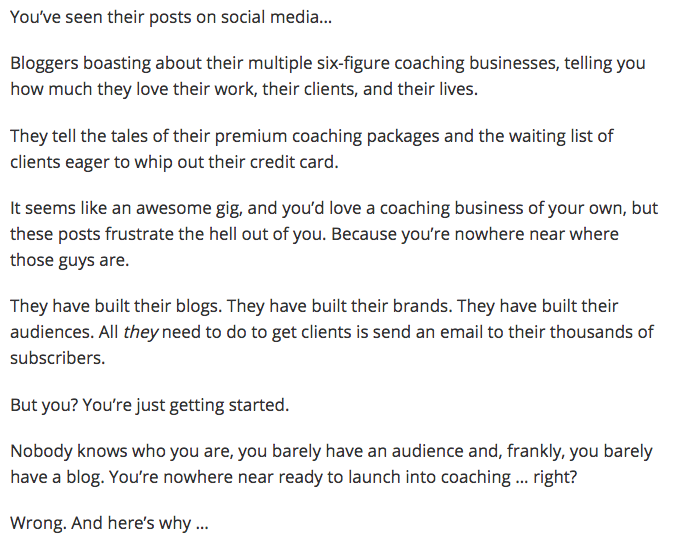
Sonia strategically pushes on the pain that she believes her target audience is experiencing.
To do this, you have to know who your audience is. In other words, if you don’t understand your target market, go back to square one before you start creating content.
In 21 Snazzy Examples to Inspire Your Own Copy, the introduction says this.
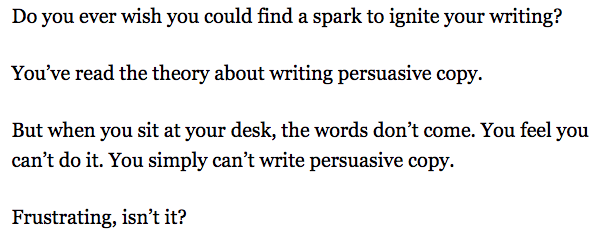
To start your piece of content, whether video, blog post, or infographic, start with the pain that your target audience is experiencing.
It’ll tell your audience that they’re in the right place and make them stick around longer than they would otherwise.
2. Be clear.
In the previous example, I could have just said, “Press on your audience’s pain point before you do anything else,” and immediately moved on to point number two.
But that wouldn’t be very convincing, would it?
Instead, I expanded upon my point because I know that some of you will need further explanation. I also know that some readers will prefer to read a bit of each point and scan from subheading to subheading — which is why I included them.
The point is that in order to create clear content, you need to make it scannable, in-depth, and full of examples.
The clearer your content, the more people will trust you, and thus, your product.
Consider, for example, how, in How to Write a Paragraph in 2017 (Yes, the Rules Have Changed), Mike Blankenship uses this image to illustrate the difference between in-print paragraph writing and online writing.

Mike could have just said that paragraphs online need to be smaller and farther apart, but he didn’t. Instead, he showed you exactly what he was talking about.
This kind of clarity increases your audience’s understanding of your content and their trust for your brand. As all great marketers know, nothing is more valuable than trust.
3. Compare yourself to your competitors.
While you don’t want to get too caught up in what your competitors are doing, it’s valuable to compare and contrast your competition with your own content marketing strategy.
But how do find your competition?
Well, with modern technology and online tools, it’s easier than ever.
To discover websites that target similar keyword phrases as your website, type your URL into Ahrefs.com.
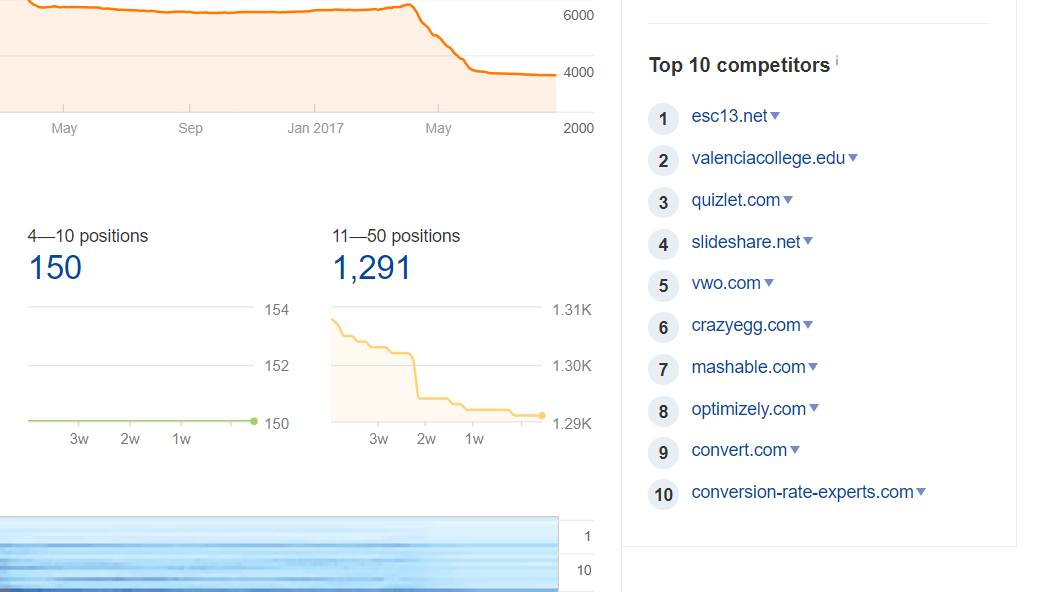
If you’re more interested in paid keywords, then you can go to iSpionage to find companies that are targeting similar AdWords keywords.
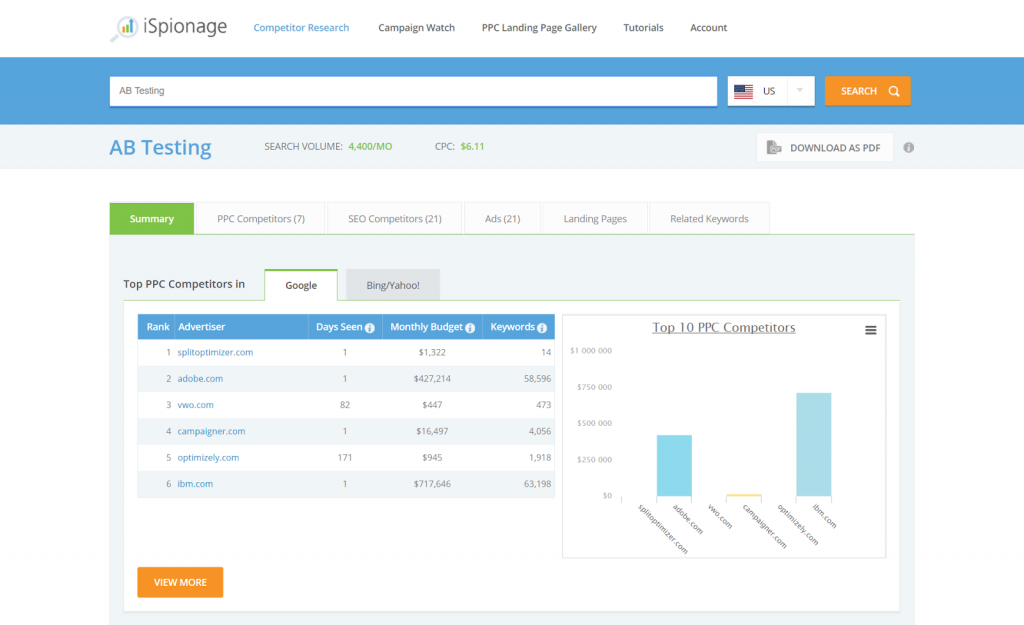
However you find your competition, ask yourself these questions about their content marketing.
- What kind of CTAs are they including in their content?
- Where are the CTAs at?
- How does your eye flow through the content?
- How do they pitch you on their product?
Then, decide if you can make any changes with your own content marketing strategy based on their website.
Pay special attention to how they subtly include links to their product or CTAs within their content. A lot of times, creating content that converts is simply a matter of writing something helpful with subtle pitches within.
4. Tell a compelling story.
You’re not writing a fiction book.
You’re writing a compelling piece of content.
But here’s the reality: if you do it right, the two won’t look all that different.
Every successful brand tells a compelling story.
And that’s because we remember stories 22 times better than we remember simple facts.
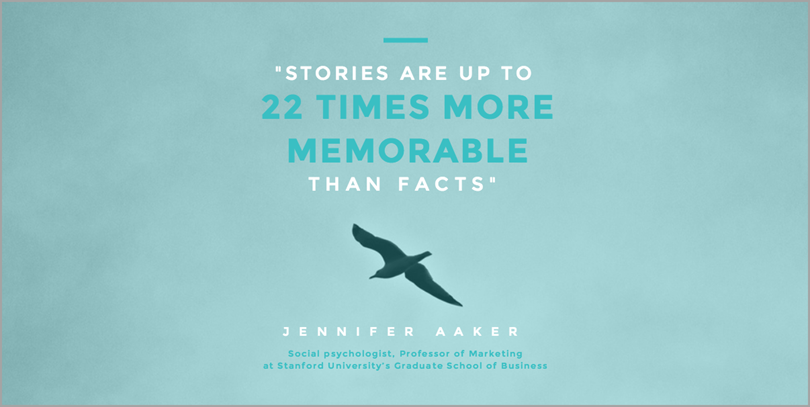
In fact, one of the best ways to strike a balance between selling your product but not being too pushy is to tell a story.
Consider, for example, if I said this:
“You should buy these shoes because your friends will think you’re cool and you’ll finally get to date that girl you want to date.”
Very few people would buy with that sort of copy. But imagine if I wrote this instead:
“You want shoes that look nice. You want people to notice them but not only them. You want shoes that you can afford, but don’t look affordable. I get it. That’s why I created these kicks.”
That’s far more compelling content.
In fact, 92% of consumers want brands to tell stories.

Instead of directly telling people why they should buy your product, tell them indirectly with a story. Make your audience the center of that story by using “you” and explain the way they’re feeling, what they want, and then how you’re going to solve that for them.
In other words, tell a narrative where the customer is the protagonist, the pain is the antagonist, and the product is the savior.
5. Keep it emotional.
Most people purchase at least partly — if not mostly — because of the emotions they experience.
They buy those new shoes because they want to look cool. They buy that new watch because they want to look smart. And they buy that new online course because they want to be successful.
So, the first thing on your plate as a content marketer is to figure out why people buy your product.
Do they buy it because they want to be more successful, because they want to appear generous to their friends, or because they want to impress the girl at the bar?
Once you answer that question, make your product emotional. Tell visitors that your product is going to solve their emotional needs.
Consider this video by Gillette where they humorously argue that facial hair is making people kiss less.
Laughs aside, Gillette turned their razors, a simple and seemingly unemotional product, into an emotional experience.
They probably even convinced some men to start shaving with their razor more regularly.
If they had just focused on the science behind how a razor works, they wouldn’t make any sales. But tell men that they’ll do more kissing if they shave, and lumberjacks all around the world will flock to your razor.
6. Jump the necessary hurdles.
No one is going to buy your product unless you convince them to.
And every person who visits your website has objections to making that leap. They won’t commit unless you help them jump the hurdles that are in their way.
First, you need to identify what hurdles stand between your visitor and the “confirm purchase” button.
It’s worth mentioning that your website’s load time makes a big difference in whether visitors convert or not. If it takes too long to load, then people will leave. The faster the load time, the better.
If you run your blog on WordPress, consider a managed WordPress hosting provider. They typically fine-tune their servers to work more effectively with WordPress.

When deciding how to address your prospect’s objections, consider this opt-in form from Velocity Partners.

This might just seem like a fun and personable email opt-in form, but Velocity Partners is actually jumping a serious hurdle with this copy.
By convincingly claiming that they are “unlikely to spam you,” they overcome the fear of endless junk that many people have when opting into an email newsletter.
If you want to sell something, make sure that your content jumps the hurdles that people will have when buying your product.
Some common hurdles include price, delivery time, quality, effectiveness, and trust for your company.
Address these accordingly.
7. Use a case-study or testimonial.
Like we talked about earlier, everyone loves a story.
And people particularly love true stories about others who’ve already used your product. Did they like it? How did it help them? What did they do to make your product the most effective?
This principle applies to both B2B and B2C companies.
Everyone wants proof that your product works. Testimonials and case studies provide that proof.
Unbounce A/B tested the science of testimonials.
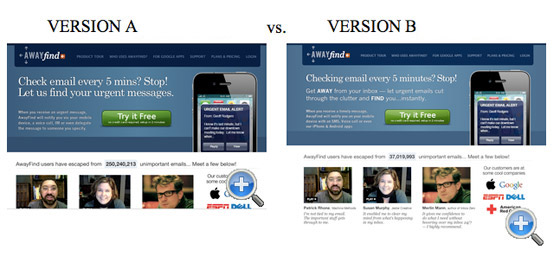
In the end, they found that testimonials increased sales by a whopping 34%.
Buyers want to know that they aren’t the first person to put their trust in your product. They want to know that other people have had amazing results and been satisfied with your business.
Case studies also provide that confidence.
At Carrot, a company that creates real estate websites, they use case study content regularly to encourage prospects to work with them.
Their blog has posts like Why A Website Developer Decided To Use Carrot To Grow His Real Estate Business and Client Case Study: From ZERO Leads To 1 Seller Lead Per Day.
They even created testimonial videos.
To make your own case studies, find people who have tried your product and loved it. Then, tell their story with a video, blog post, or podcast episode.
8. Test everything.
In the end, you’ll only know if your content is converting if you test it.
The best way to discover what works and what doesn’t is by running A/B tests, asking your clients questions, and reading online data.
Google’s Content Experiments allows you to run A/B tests on web pages.
For example, if you want to craft a piece of content that’s optimized for conversion, you can use Content Experiments to run A/B tests to see which style performs best.
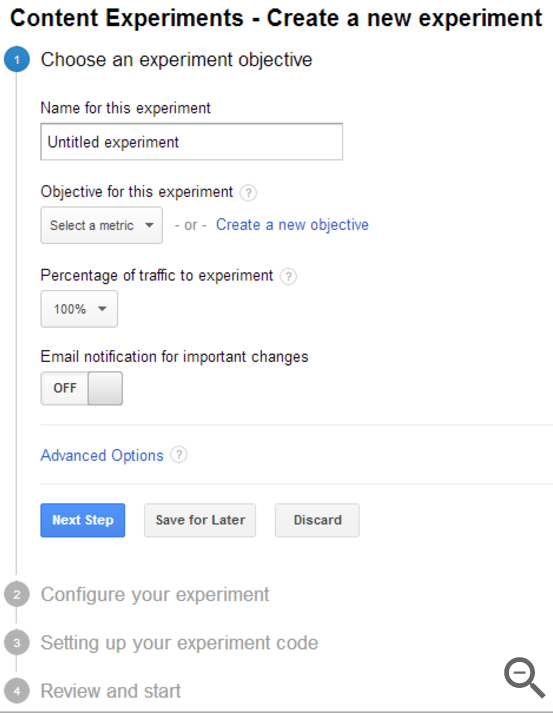
Here’s a list of things you should test in each piece of content.
- Call to action (CTA) placement on your website.
- Sales copy.
- Image optimization.
Test these to find out what works and what doesn’t. There’s a good chance that one thing will work for you but not for someone else. Every business is different, and so is their content marketing strategy.
This means you need to test everything for yourself.
Find the right balance.
Creating content that is helpful and sells your product is a challenge.
Often times, you’ll find yourself being too heavy-handed. And other times, you won’t be heavy-handed enough.
But if you must err on one side or the other, err on the side of creating helpful content. The more helpful your content is, the more people will trust you and look into buying your product.
If you do it correctly, your content will sell your business and product simply because it’s good content.
But to make sure you’re striking a healthy balance, make your content hurt a little, make it clear, tell a compelling story with emotion, jump the necessary hurdles, and use social proof.
At one time, the salesperson was only in it for himself. But today, we first have to provide value for our audience. Then, and only then, you’ll make a sale.


